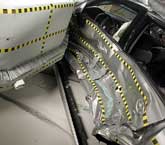Recent Articles
Popular Makes
Body Types
Insurance Institute of Highway Safety
How cars crash could save your life
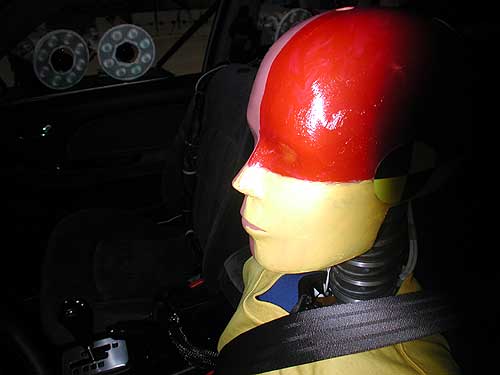
There is no sound at that moment when a car collides. The point of impact is a pause, followed by the scream of shattering glass and corkscrewed metal. It is a space, a held breath, a second when there is nothing but the deep inhale of air between two onrushing objects. Strange things happen in the space when cars collide. And no one can ever know everything that happens when hell is loose and the glass breaks. It is, perhaps, the purest form of chaos, and measuring that chaos is what the Insurance Institute of Highway Safety does. Tucked away in the hills of Virginia, the Institute's VRC -- Vehicle Research Center -- is where they examine that pause, reproduce it, watch it and measure it until they know everything possible about what can happen when a real accident occurs. Their goal is to reduce injuries and improve vehicle safety, and since the VRC opened in 1992 the Insurance Institute has had a strong role in instrumented crash tests and component testing.
Page 2: NHTSA, IIHS Testing Differences
NHTSA, IIHS Testing Differences In essence, they try to put a pattern to chaos. In doing so they try to make it so that chaos doesn't happen to the people involved in a vehicle crash, whether it is a minor fender bender or a major impact. They crash cars for a living here, and have turned it into a life-saving science. Arguably, their testing is more up-to-date and "real world" than any other, including the government's testing at the National Highway Traffic Safety Administration (NHTSA), though both sources provide a critical overview of specific vehicle safety. Since 1978, NHTSA has conducted a 35 mph full frontal test where the full width of the front end of the vehicle hits a rigid barrier. One of the Institute's primary tests is a frontal offset, during which 40 percent of a vehicle's front end hits a deformable barrier at 40 mph. Unlike the NHTSA barrier, the Institute's barrier is designed to mimic the height, weight and width of a common SUV, and the offset angle is meant to replicate the most common accident scenario. The Institute has been conducting this test since 1995, and since then automakers have learned to either love or hate the folks in the Virginia farmhouse, depending on how their cars rate. To watch a group of automaker reps at the site of a testing is akin to watching first-time fathers in the hospital waiting room - or a guilty defendant and his lawyer outside the courtroom doors. "Our mandate is to find ways to reduce deaths, injuries and costs, and drive vehicle design improvements," said Brian O'Neil, president of the Insurance Institute of Highway Safety. "Safety has become a hot button, and we're seeing vehicle improvements through the worldwide marketplace. The paradigm has shifted."
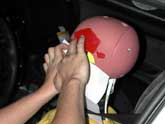
Page 3: Safety Displayed
Safety Displayed This is serious business. Walk into the Institute and you are immediately confronted with two old and crumpled cars, on display as if they are for sale. These are the first-ever cars crashed for the explicit reason of finding out what would happen, and it's not pretty. Wander deeper into the institute and a strange dichotomy smacks you across the face: Here, at this idyllic location and in this spotless white building with gleaming floors, sit hundreds of crashed, crumpled and leaking vehicles. You can almost see the blood stains. Row upon row, these crashed vehicles are neatly labeled and explained and sorted by category. The display is a clear illustration of who makes the most dangerous cars, and, brutally, why. Off to the side with its own place of honor is a two-car pile up, both Fords and both badly beaten. The Explorer had hit the Focus on the side in a test conducted to prove the value of side air bags - proof vividly illustrated by a dark swath of face paint on the hood of the Ford Explorer. It's one of the more recent safety issues that the Institute has begun testing. As a result of their research and tests, O'Neil says that side airbags are important -- but what's even more critical is the type of airbag, because the point of side airbags is to protect the head. "It's not as necessary to protect the torso with an airbag," O'Neil says. "A side airbag that protects the head is a requirement."
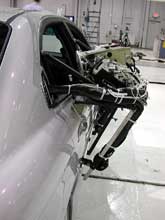
Page 4: Face Paint and 750,000 watts
Face Paint and 750,000 watts Face paint - go figure. Yet with all the technology built into the Institute's testing facility, the most dramatic and visually conclusive evidence of how a car performs in a test is face paint, applied to the face and head of the high-tech dummies placed inside a car. The technicians who apply the face paint do so carefully, as if the dummy were sitting inside a green room just off stage, instead of in the middle of what is surely one of the whitest, brightest rooms ever built. Measuring 21,600 square feet, the Institute's "crash hall" is illuminated by 750,000 watts of glare-free light and is used for barrier tests, vehicle-to-vehicle head-on, frontal offset, and front-to-side impacts while vehicles are in motion. At the center of the hall is the crash area, flanked by concrete barriers, and a black galvanized steel observation balcony hangs off the south wall. The engineers and automaker reps stand outside the circle of concrete, and in the case of a barrier test, the vehicle to be tested is placed in the center of the hall and hooked up to cables, computers and cameras, each meant to measure intrusion into the vehicle and passenger movement inside the cabin. When it comes to frontal offset crash tests, the Institute's evaluation is based on three measurements: occupant compartment intrusion, injury from a crash test dummy in the driver seat, and study of slow-motion film examining how well the restraint system controlled dummy movement. To reach that collection of data, absolutely nothing can go wrong. The vehicle must start; dummies must be painted, connected and in place; everything must exactly replicate the proper accident scenario. This is where Brian O'Neil, president of the Institute and passionate advocate of crash testing, gets serious: the money and time invested in conducting a test is significant and not easily brushed aside. But if the test is flawed in any way, so then are the results - and the outcome must contain no flaws. Once all systems go green, the small roll door opens under the balcony and the barrier begins to growl, shake and gallop, gaining speed with each passing yard until it reaches 40 mph and slams into the vehicle. At the moment of impact, everything is fluid; test dummies flail and bounce around the cabin, the car undulates and lifts, landing perhaps 50 feet from the impact spot.
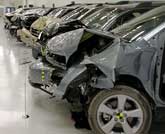
Page 5: Post-Crash Testing
Post-Crash Testing And at that brief moment of impact - at the point of silence before the shower of glass - the cameras whirr and the Institute records the chaos of motion and contact, to be studied and graded. As pristine and scientific as the lead-up is, the post-test scene is equal in its technical destruction. The car is shattered and caved; the dummies have bounced off B-pillars and head restraints. The vehicle is leaking fluid on the cold white floor and there is an army of very smart people - scientists, engineers and the like - who are peering inside the cabin and furiously taking measurements and writing notes. This is where a car makes its name. A "Good" rating generally means that a vehicle has passed the core tests of injury risk, intrusion and restraint measurement, as compared to similar vehicles. Acceptable and Poor ratings follow Good, and make up a grading criteria that is stark, to the point and lacking in marketing spin. Though the Insurance Institute does label "Best Picks" in most categories, most of the grading in their offset crash testing is specifically related to the three criteria: restraints, intrusion and injury risk. These three together help the Institute get a bead on what will happen when, far from white halls and Virginia hills, that sound of silence is pierced by the crashing sound of skidding rubber and sirens.
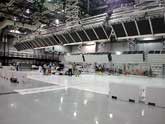
Page 6: FAQs
What's the difference between the Insurance Institute for Highway Safety (IIHS) and the government's agency, NHTSA? First, they test different things and do their tests differently. For example, the Institute conducts frontal offset crash tests, where the National Highway Traffic Safety Administration (NHTSA) uses a full frontal approach. The Insurance Institute also uses a barrier sled designed to mimic the bumper of an SUV. How long has the Institute been testing vehicles? The IIHS has tested vehicles and provided safety information for many years, but it wasn't until 1992 that they began crash testing the way they do now. In 1005, the VRC opened. How does the IIHS determine ratings? When it comes to frontal offset testing, they use three criteria: injury risk, intrusion and effectiveness of safety restraints. How does the IIHS stay in business? Through funding from a group of insurance companies. The idea is to find way to make cars safe, reduce injuries and lower insurance premiums. How does the IIHS rate vehicles? The IIHS uses are simple three tier rating system: Good, Acceptable, and Poor.
